how (and when) to trim the spurs on your rooster: the right way
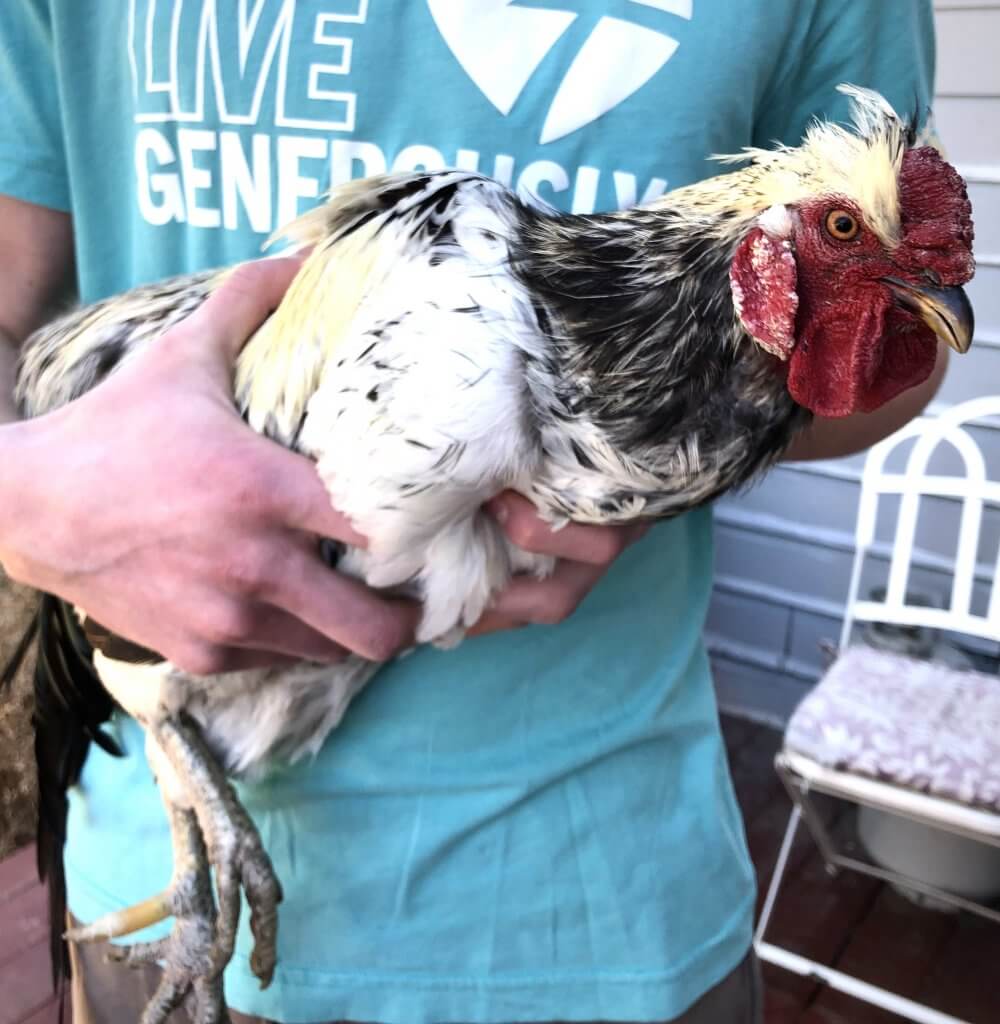
This is Stan. I do believe the most difficult part of trimming his spurs was catching him! He was quite determined to remain FREE and at large!
Learn how to trim the spurs of your rooster the right way, and what items you need to do the job safely and without hurting your roo.
First rule: Don’t hurt your roo
There is a modicum of bad advice zipping around the interwebs about how to trim the spurs of your rooster, when to trim them, and even if you need to trim at all. There are as many preferred tools for the job as there are chicken keepers, it seems. I don’t think there’s just one safe and effective way to trim the spurs of your rooster, but my first rule to follow is to avoid hurting my roo. This rule therefore eliminates a couple of common spur-trimming recommendations. Read on to see what they are, and to also learn how we accomplish this feat at our farm.
Since this is such a controversial topic, today we here at vomitingchicken.com are asking an impartial third party source to weigh in on the topic: Mrs. Farmer Answer Person (MFAP for short).
A hearty welcome to Mrs. Farmer Answer Person!
MFAP: Thank you very much! Such an honor!
VC: Let’s get right to the questions! Here’s our first caller, Ida Claire Ya’ll:
Ida: Hi MFAP! Hey, do the spurs really have to be trimmed at all? It looks like it could be dangerous process–to me, and to my Rooster Gerald–and anyway I’m of a more “natural” bent anyway. I don’t wear shoes, myself. For example. Let sleeping dogs lie. Live and let live. Et al. It doesn’t seem natural to cut off those bad boys.
Q: Do the spurs really need to be trimmed at all?
MFAP: Yes, Ida, the spurs need to be trimmed, and possibly, in some cases . . . no. As you probably know, the spurs are the rooster’s defense against predators, and they can actually do some damage with them. But they will also do damage to hens, in their more . . (cough) intimate moments . . . that is, during mating . . . and if you have a roo that is prone to flying up at you, the spurs can be dangerous to you, too.
Probably–if your roo does grow long spurs (not all roos do*)–those spurs will need to be trimmed at some point. Think of your own fingernails. Can you imagine how unhandy they’d be if you didn’t trim them occasionally? It’s the same with your roo’s spurs (and his toenails, too, but that’s another subject for another day).
Another bad thing about untrimmed spurs is that they may get so long that they start to actually scrape the inside of the roo’s legs, which can make him very unhappy indeed. And lame. (Not lame as in “that’s so lame, dude,” but actually lame.)
A salient point: not all roos grow long spurs
However! *Many commercial breeds have had this spur-growing tendency bred out of them. The heritage breeds will still grow long spurs, as will the game birds and many others, too, including Icelandics. Occasionally a hen will grow long spurs, as well.
VC: Our second question is from Alphie Bet:
Al: Howdy there, Missus FAP! So you’re a chicken authority, eh? I read somewhere on the interwebs–I believe it was on the Googles–that using a hot potato to twist the old spur off is easier and better than whatever possibly-cockamamee method you’re gonna suggest. No offense. What’s your opinion about this?
Q: What about the hot potato method?
MFAP: Tsk, tsk. No offense taken, but I don’t agree at all, Alphie. Remember our first rule: a Hippocratic oath, in a sense, of animal husbandry: Don’t Hurt Your Roo. In fact, I know how this barbaric hot potato practice started. My own grandpa, Grandpa Farmer Answer Person, told me a story that happened in the Appalachian hill country, decades ago. To wit.
Where the hot potato method came from
A young lad was outdoors chawing on a fresh hot baked potato. A mean ole’ rooster came charging up to him and, in his fright, the lad threw the spud at him. It lodged–weirdly–smack dab on one of the bird’s spurs, which hadn’t been trimmed in a long time (someone like Ida was letting the fellow live and let live, apparently). In fact his spurs had become dangerously long and sharp.
That lad wasn’t about to let that ole roo take off with his hot lunch, so he chased him down, tackled him, and grabbed his potato, twisting it quickly off the spur. To his astonishment, the spur came clean off in the hot potato, leaving only the pale bloody stub behind!
Alphie–though it’s a quick, rather novel, high starch way to remove your roo’s spur, and a natural thing to do with the leftover baked potato after supper, it’s a barbaric practice that should be abandoned, in my humble (but correct!) opinion.
The heat from the spud can actually burn the skin at the base of the spur. And twisting the old spur off, leaving only the tender stub behind is something that could hurt the poor roo as well. That tender nub that’s left may possibly be very painful to the roo until the new spur grows in and hardens. Possible burns and painful tenderness? Run away from the hot potato method, Alphie. Run like an Appalachian lad away from a temperamental rooster!
VC: Err, my goodness, that is informative, and a bit shocking too!
Question #3 is from Ginny Minny Skinny Winnie:
GinMinSkinWin: Hi there MFAP! Say. I’ve got an old dull rusty pair of dog nail clippers that I dug out of my kids’ sand pile that had been there for three years and has a piece missing, but dangit, it still works! Can I use them to trim the spurs?
Q: Can I use my old dog nail clippers?
MFAPerson: Ginny. I’d avoid using your dull clippers. A sharp pair may work, if your hands are strong enough to make a quick cut. The risky thing about using any clippers, dull or sharp, rusty or new, is that it’s easy to crack the spur with those clippers. That appendage can be very hard and tough to cut! A cracked spur stump is to be avoided, of course, as it can catch on something, snag and pull the entire spur off.
VC: Here’s another question, from our caller Claude Hopper:
Claude: Yeah, well, Misses Farmer Answer Person, my cousin Lonnie just twists off the old spurs with a pair of pliers. It’s real neat and fast. Why not just do that?
Q: What about the “twist with a pair of pliers” method?
MFAP: Good question, Claude! My advice would be the same as with the hot potato method: it may be neat and fast, but it can damage the skin around the spur, and it leaves that tender bit behind–which is still pointed, by the way. I wouldn’t recommend it. It can leave the roo in a pickle of pain, and without any defenses.
VC: Our last question for today is a good one, from Geraldine Pink:
Ms. Pink: So MFAP, Okay, what IS the best way to trim those spurs? I’ve got chores waiting for me, ya know. My goats don’t milk themselves.
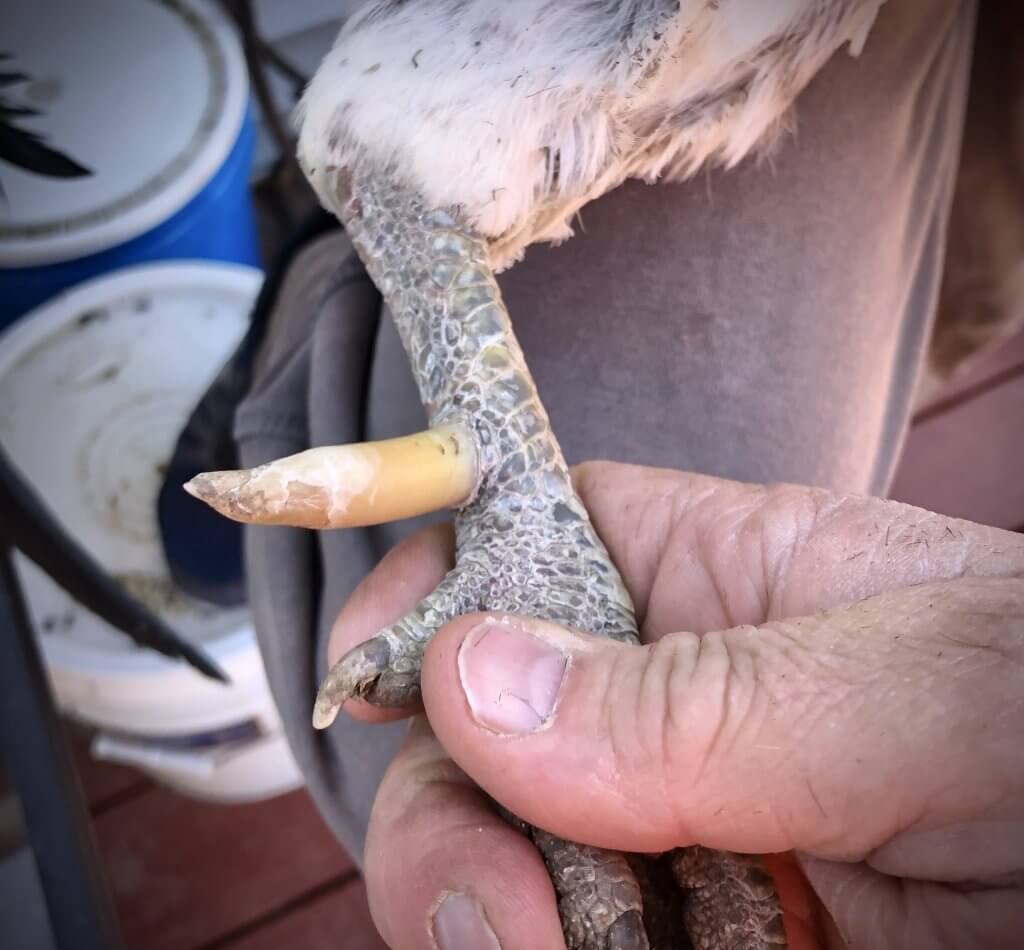
Q: So how do you trim the spurs on your rooster?
MFAP: Here’s what I recommend: Get a friend to help you, first. Then use a battery-operated or electric hacksaw–which is a very handy little tool to add to your tool collection, if you don’t have one already–and trim the spur very carefully from the pointed end in.
If you don’t want to use the electric saw–you need strong and steady hands to use it, so you don’t accidentally nick the roo or yourself–you can use a small sharp hacksaw, or a pair of clippers. I’ve also heard of people using a Dremel tool fitted with a sander.
Important note: Though I’ve seen directions to cut just 3/4″ from the leg, or 1/2″ from the leg, you just don’t know how long the blood vessel is that runs down the middle of the spur. So what I recommend is to sand or file or clip the end of the spur, about 1/4″ at a time, until the spur is blunt and about 1″ long. Any closer than that, and you may nick the blood vessel, making the roo bleed. I’ve seen this happen, and it is rather upsetting! In fact, I did it myself once and I was a full 1.5″ away from the leg when it happened. I always keep cornstarch or stypic powder (see the “shop this post” section below) with me, as this does happen.
VC: Does this hurt the roo? You know my ‘phone is going to be ringing off the hook with this question!
MFAP: If you trim the spurs carefully, and don’t get too close to the quick, it doesn’t hurt the roo any more than you are hurt by trimming your fingernails. That is to say, not at all, if done properly.
If you get too close to the quick, or the living part of the spur, it will hurt the roo and will feel as painful and tender as when you trim your nails too close to the quick. Ouch!
Recap: What’s the best way to trim my rooster’s spurs?
- First, locate a strong friend (who owes you a favor) who is willing to hold your roo very securely.
- With one hand, hold the rooster’s spur, and with the other hold an electric handsaw with a short, sharp blade, or a small hacksaw, a sharp pair of clippers, or a Dremel saw outfitted with a sander.
- Very carefully and firmly cut the spur, at 1/4″ increments, from the sharp end in. Stop when you are 1″ away from the roo’s leg, or earlier if you get a spot of blood. Take your time and be very careful not to nick the roo. Or yourself, obviously. And especially not your friend!
- Repeat with the other spur.
- Apply cornstarch or styptic powder if the spur bleeds (it shouldn’t, but now and then it will).
In the weeds, possibly, but nice to know:
Before Mrs. Farmer Answer Person took off to help another blogger who needed a credible source on animal husbandry matters, she shared the following with me:
- A chicken’s spur is actually an outgrowth of the leg bone, consisting of soft tissue covered with a protective sheath made of the same tough keratinous material that makes up the chicken’s claws and beak. The spur starts out as a little bony bump. As the chicken matures, the spur grows longer, curves, hardens and develops a sharp pointed tip. Spurs are more common in roosters, although some hens also grow them.
- One blood vessel runs down the center of the spur. As you trim spurs regularly (which I hope I’ve convinced you to do), the blood vessel will recede. If you nick the very end of the blood vessel, it won’t hurt the roo, but the spur will bleed.
- Spurs continue to grow throughout a chicken’s life. And, just like a chicken’s toenails, they must be trimmed regularly. Long, sharp spurs require regular trimming to keep them short and blunt. From my experience, the older the roo, the slower the spurs grow.
what you need to safely trim your rooster’s spurs
- A faithful friend or relation with steady hands, to hold the bird firmly. Make it an event! Make him/her a cup of coffee and get out the cookies afterward. The good cookies. The ones you’re hiding under the saltines in the pantry.
- A hacksaw with a sharp blade works, or an electric or battery-operated hand saw with a new fine blade. In a pinch, I’ve also used a dog nail clipper.
- A small amount of cornstarch, or styptic powder, in case the stump bleeds.
Step 1: Catch your roo and hold firmly.
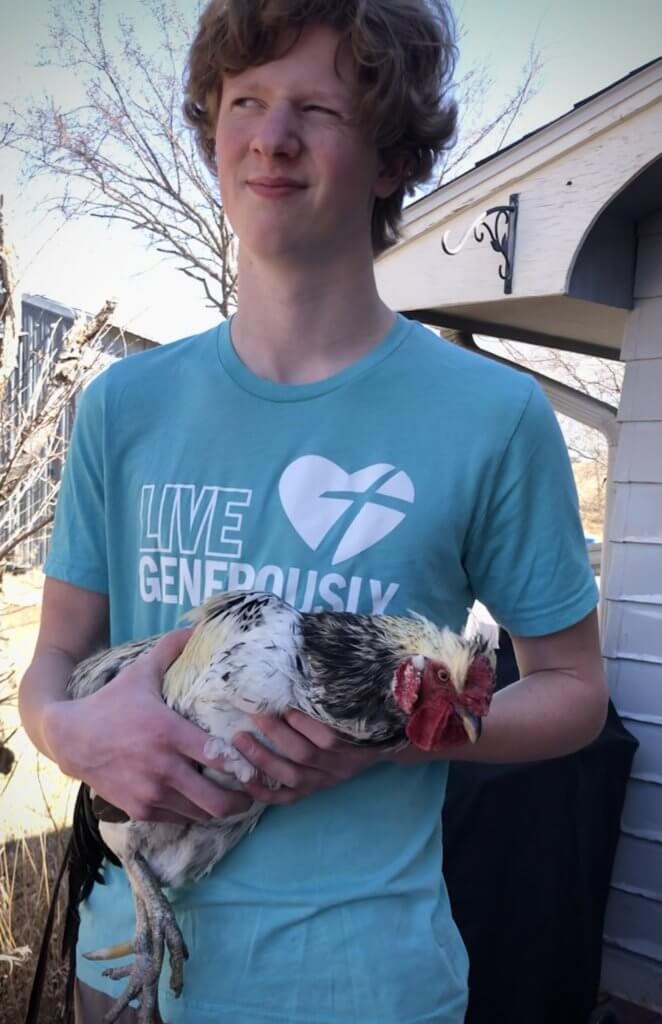
Step 2: Start at the pointed end and cut off 1/4″ at a time, until you reach a point approximately 3/4″ to 1″ from the leg. Or sooner if you get a spot of blood.
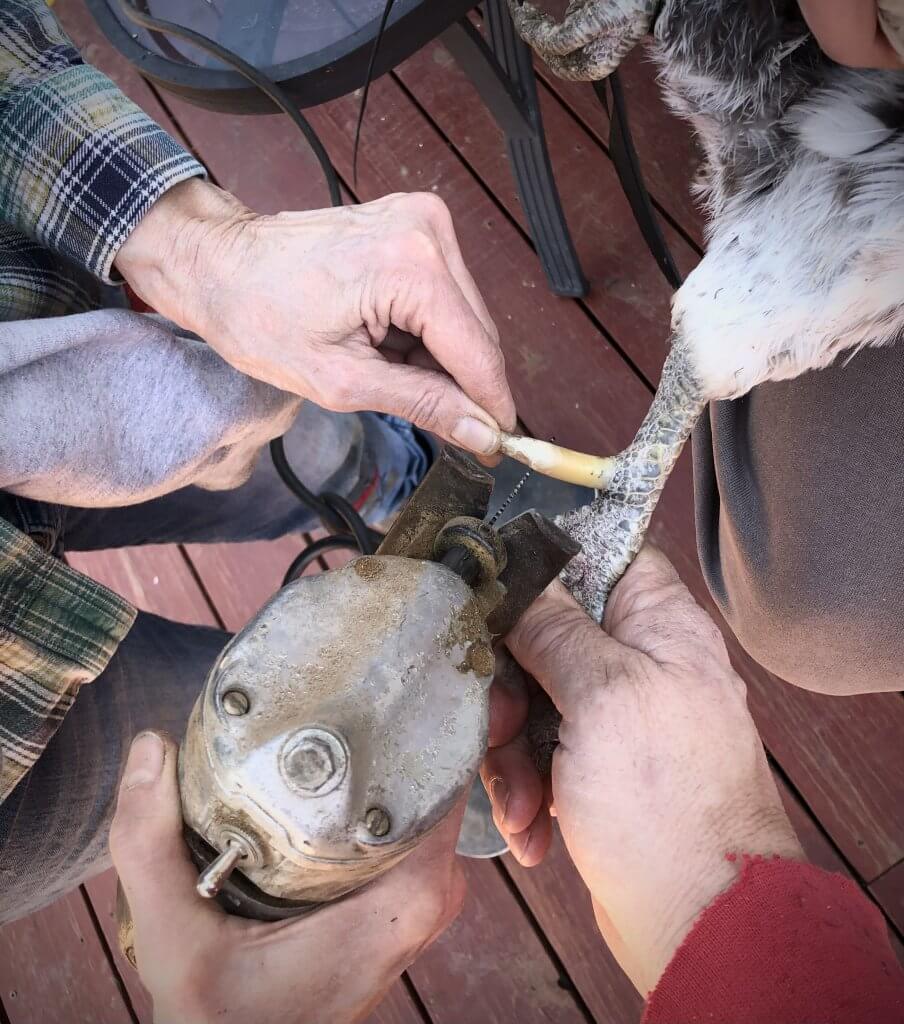
Step 3: If any blood appears on the stump, dust with cornstarch or styptic powder.
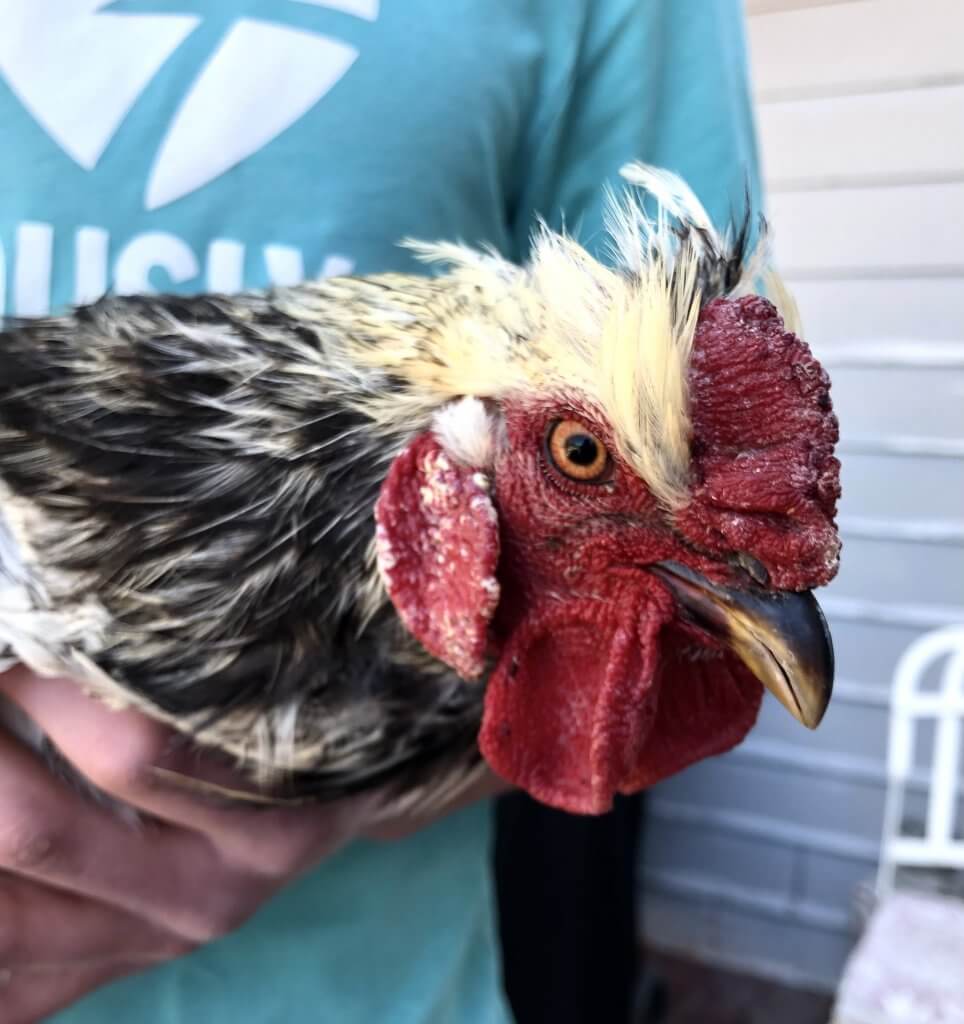
Shop this post
The following is an affiliate link, and if you click through and purchase anything, I’ll earn a small commission with no additional cost to you. Full affiliate disclosure right here.
1. I borrowed a little electric saw from my Dad, but if you want to add this dandy little electric hacksaw to your arsenal of power tools, it is the kind I would use to trim my roosters’ spurs.
2. Stypic powder is cheap and effective to use on your roo’s spur stump if you happen to nick the blood vessel. Cornstarch is an acceptable substitute.
3. A Dremel tool, like this one used to grind down dog nails, can work well and is a many-purpose tool, too!
4. A small hand hacksaw is also a good choice.
Pin it for later
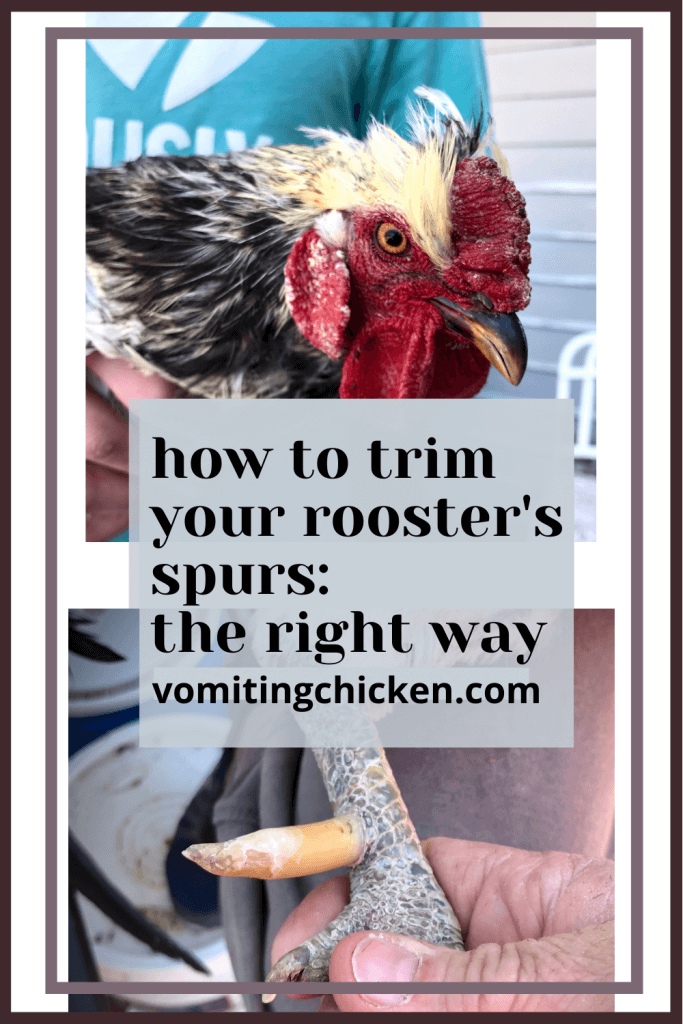
Thanks for popping in, gentle reader! I’d love to read any comments you care to make–especially if you’d like to weigh in on how you trim your rooster’s spurs–and if you like this post or think of somebody who might appreciate it, would you share it with them? Thank you!
*hugs*
p.s. (*Come back for more on my new obsession with power tools for the homesteading lady! Drop your email address in the box underneath my face and you’ll not miss a post!)
- crunchy homemade training treats for dogs: cheap and simple!
- YES you CAN make artisan bread in 5 minutes: here’s how!






My parents raised chickens, and my dad battled a fierce rooster with spurs more than once. I didn’t know until coming across your article that one could even trim the spurs! I hope to raise chickens someday soon, so I’ll have to keep this in mind.
Sarah, we gave up on “rehabilitating” roosters years and years ago. My hubby tried to teach a bantam roo “The Little General” how to behave himself, but he just got meaner and meaner as time went on. Eventually he ended up in the soup pot, since we had a little daughter that he liked to pick on.
Haha thanks for this post. The unglamorous side of chicken keeping.
Dee . . . errrm. . . stick with me, kid, and you’ll see plenty of “unglamorous” moments in the chicken yard, haha! That’s life, though!
We trimmed our head rooster’s spurs last week, as they had grown long enough to trip him up when walking. My husband held him while I very carefully used a Dremel tool to grind them down. It was stressful, but he was much happier and more comfortable after. We use the same technique on one of our other birds whose lower beak is longer than his upper. A wee trim every couple of weeks keeps it under control and allows him to eat and drink much more easily.
I think using the Dremel tool (and a hubby with strong hands) is a great combination, Denisa! Your birds surely appreciate your tender care (or at least it’s fun to think that they do, haha).
How often should I trim the spurs and nails?
Drew, I only trim mine when they seem to be either bothering the rooster, or if they look threatening to the hens. It’s kind of a personal preference thing!
Drew, it depends on the roo. Depending on their breed, some roos grow their spurs and nails very quickly, and others don’t. I just keep an eye on them. If the spurs are starting to look threatening, I give them a trim!
Hi. Reading more about yourself, I share many of your values. But I would recommend a few sheep (only ewes for their superior temperament) instead of goats. Goats are browsers and will prefer all your favorite rose bushes, flowers and even poisonous rhododendron to grass. Sheep have nicer voices, and ewes generally have no horns to knock down your kids. Rams, bucks and does (goats) have horns that can feel like being beaten with a Louisville Slugger if they get annoyed.
Terri,
Oh, thank you for your recommendation! Lately I’ve been longing for a couple dairy sheep. We’ll see if I can coax hubby around to it . . .
Thank you for this post. I was out with my little flock this morning and realized that my 2yo Roo, Mr. Duke, has started to hurt the hen’s wings during.. courtship. When I glanced at his spurs I realized they’d grown a whole lot longer this spring and now they’re starting to curve upward. Duke is a REAL BIG roo so I think I’ll go dremmel method and have my REAL BIG son help hold him. If that doesn’t work though, what are your thoughts on a culling cone to keep him calm while he gets this pedicure of sorts?
Hmmm . . . I would be surprised if you and your REAL BIG son can’t hold him still enough to trim those bad boys. Usually a roo (or a hen,for that matter), once caught and held very tightly, will relax and submit to . . . whatever. If he continues to thrash around, I’d use the cone rather than risk hurting him. Be careful, though! It’s so easy to nick a roo’s leg if you aren’t able to get him to hold perfectly still, and then the blood will fly!
Touching a bright light to one side of the spur and looking at the other side with the light shining through the spur makes it much easier to see where the quick ends.
That’s brilliant! I’ll remember that the next time I need to trim spurs! Thank you!
Oh, that’s a great tip! Thank you!